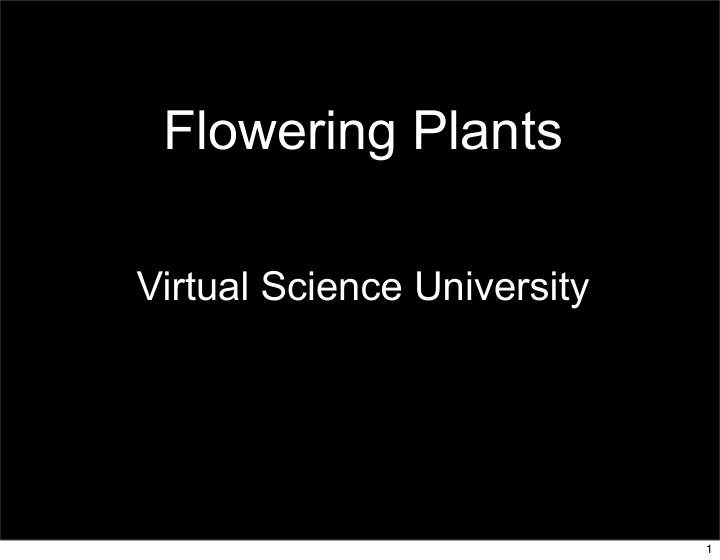



Flowering Plants Virtual Science University 1
Flowering Plants Texas TEK B.10 (C) Student will analyze and identify characteristics of plant systems and subsystems. 2
Flower, Your Scent Is So Sweet Flower, Your Scent Is So Sweet! Flower, where is your little Stigma? Flower, where is your little Stamen? Flower, Let’s mix in a little pollen Oh! Oh! It smells like Cinnamon, Oh So Sweet! Flower, is your Carpel made up Of a Stigma and Ovary? Flower, is your Stamen made up Of an anther releasing Pollen Flower! Your Scent is So Sweet! -3X 3
Introduction to Flowering Plants • If you have ever stopped to smell the roses, then you are familiar with the largest group of plants, the Angiospermae. • The distinctive feature of this group is the flower, a cluster of highly- specialized leaves which participate in reproduction. 4
Introduction to Flowering Plants • Not all flowers are as conspicuous as the plant blossom in the picture • Oaks, ivy, & grasses also produce flowers, but because they are not as showy we often do not notice them. 5
Introduction to Flowering Plants • The flowering plants are important in many ways above and beyond their appeal in flower arrangements. • Not a day goes by in which our lives are not affected by flowering plants. 6
Introduction to Flowering Plants • Nearly all of our food comes from flowering plants; grains, beans, nuts, fruits, vegetables, herbs and spices almost all come from plants with flowers, as do tea, coffee, chocolate, wine, beer, tequila, & cola. 7
Introduction to Flowering Plants • Much of our clothing comes from them as well -- cotton and linen are made from "fibers" of flowering plants, as are rope and burlap, and many commercial dyes are extracted from other flowering plants. 8
Introduction to Flowering Plants • We also owe them credit for a large number of our drugs, including over-the- counter medicines such as aspirin, prescribed drugs such as digitalis and atropine, and controlled drugs such as opium, cocaine, and tobacco. 9
Fossilized Record It is a mystery ? • The rapid diversification of angiosperm taxa began in the Albian, in the mid-Cretaceous, 144 to 65 million years ago, and has continued to this day. • At that time, there is an almost exponential increase in angiosperm diversity, and there does not appear to have been any major extinctions of groups in between. • Despite the large numbers of taxa that are known from rather early in this diversification, there is no indication of where the taxa are coming from. • D.I. Axelrod has suggested that we do not find early angiosperm fossils because the earliest angiosperms lived in dry, upland habitats where they were unlikely to be preserved as fossils. • Though this idea has long been accepted, it has not been well investigated and so remains to be tested. 10
Structure of a Flowering Plant • Like other seed plants, angiosperms are heterosporangiate – producing pollen and ovules in different organs • Unlike most seed plants, however, the pollen and ovule-bearing organs are usually produced together in a bisporangiate cluster called a flower. 11
Structure of a Flowering Plant • In the center of a typical flower are the carpels, modified leaves which enclose the ovules. • These are often fused to form a single pistil in the center of the flower. 12
Structure of a Flowering Plant • Surrounding the carpels are several narrow stalks topped by pollen sacs; these pollen- bearing stalks are called stamens. • Around these reproductive organs is the perianth, usually consisting of an outer whorl of sepals and an inner whorl of petals. 13
Structure of a Flowering Plant 14
Structure of a Flowering Plant • In monocots and "primitive" dicots, the sepals and petals may be indistinguishable, as in the lily shown at right. • In this case the perianth parts are called petals. 15
Structure of a Flowering Plant • The first flowering plants had numerous floral parts spiralled around a central axis, much like the flowers of Magnolia . • In most angiosperms, however, the floral parts are relatively few, and are arranged in a whorl, in which a set of parts are all attached around the central axis at the same level, instead of being attached in a staggered spiral. 16
Structure of a Flowering Plant • The parts of these earliest flowers were likely very large and radialy arranged; they were not fused to each other, as is common in many groups today. • In many angiosperms, the flowers are arranged in clusters called inflorescences. • The flowers may be attached along a tall stalk, arranged in broad open clusters, or pressed tightly together so that the cluster looks like a single flower. 17
18
What Does Angiosperm Mean? • Angiosperms differ from other seed plants in that they enclose their ovules (and seeds) within a carpel. • The carpel is a modified leaf bearing the ovules, but the carpel is folded onto itself, wrapping the ovules inside. • The "vessel" which the carpel forms gives the angiosperms their name. 19
What Does Angiosperm Mean? • Although the carpels are hypothesized to give extra protection to the developing ovules and seeds, there is a problem with encasing the ovules -- how to get the pollen to the ovule so that it can deliver the sperm? • In angiopserms, the pollen tube does not simply grow through an opening in the tissue surrounding the ovule, but it must penetrate and grow through the tissue. 20
Fertilization 21
Angiosperm Reproduction 22
Contact Information www.VirtualScienceUniversity.com 1-877-920-5550 23
Recommend
More recommend